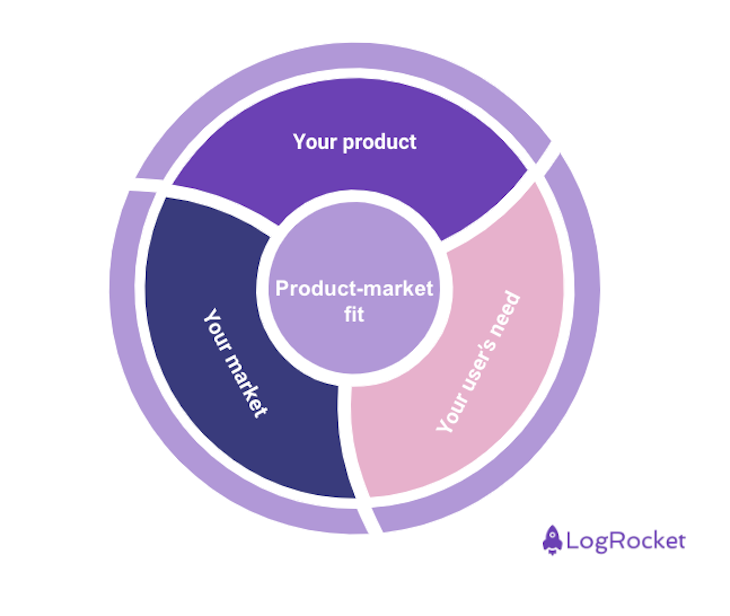If you’re a product manager, you’ve probably heard of product-market fit. However, it can be elusive and unless you’re at a fast-growing company with endless, rapid growth, product-market fit is hard to recognize. This difficulty has led some people to suggest that product-market fit is just a myth.

That said, product-market fit isn’t a myth, but it’s over-simplified, over-quoted, and often misunderstood.
In this article, you will learn what product-market fit is, the components that influence it, and how you can achieve it for your own product.
Product-market fit occurs when you build a product that fits a direct need that a market already has. This allows you to provide immediate value to users who are seeking a solution for a problem that they’re experiencing. As Marc Andreessen says, “Product-market fit means being in a good market with a product that can satisfy that market.”
This might seem like a pretty straightforward definition, but there’s actually quite a bit of nuance involved.
You can’t just build a product for a market, you also have to judge the quality of the product, market, and need. All of these components come together to determine product-market fit.
Product-market fit relies on the relationship between three essential components:

Your product has to be significantly better than the status quo, but how “good” your product needs to be is dependent on your market and the urgency of need. For mature markets with many viable solutions, your product needs to go above and beyond, covering a core set of must-have features.
Some mature markets that come to mind are phones (you really can’t sell a flip phone these days) or CRMs (everyone needs a bunch of features that Salesforce provides).
In more nascent markets, people will forgive your product for shortcomings if it can solve a really important problem.
The quality of the market is completely out of your control, but without a good market you won’t be able to achieve product-market fit. For example, returning to flip phones, if you shipped a flip phone today, some hobbyists might buy it, but would you see escape growth velocity?
Because the market is out of your control, you need to choose the right market to target in the first place. Iterating into the right market is key for achieving product-market fit.
Your user’s need is critical because it points towards the urgency of the desire for your product. Building something that a market truly needs will drive faster sales cycles, as customers will want the product in their hands as quickly as possible.
Of course, need is arbitrary, as one might say that you absolutely need to see the new Mission Impossible movie in theaters. However, a sense of urgency within a market, and the fact that you’re driving that urgency with your product is key to product-market fit.
At this point, you might be asking yourself, how do you know if you’ve reached product-market fit? Well, if you’re asking yourself whether or not you’ve reached product-market fit, you probably haven’t. Product-market fit should be obvious, and if it isn’t, you might have reached certain steps that will lead you to product-market fit, but you haven’t gotten there yet.
Product-market fit is really about scale. Are you able to get customers to repeatedly use your product? Are your customers net promoters of your product? Are you able to drive top-of-funnel pipelines in an exponential (versus linear) way?
If you’ve reached product-market fit, you’ll have developed enough of an understanding of your business to know how to scale your business. Numbers wise, you should be seeing an upward slope in your usage chart. If you’re not seeing that… you’re not at product-market fit yet.
The biggest oversimplification of product market fit comes from thinking that it’s binary. Product-market fit occurs on a spectrum, and it’s more appropriate to think about it as a journey you embark on while building a company.
Early on, you might be doing user interviews with dozens of customers. You might see some initial product-market fit within those interviews. Then, you go out and build an initial MVP and discover that the market doesn’t want what you’ve built, so you go back to the drawing board.
With each iteration, you’re getting closer and closer to product-market fit.
Even as you start selling products, product-market fit isn’t just a switch that turns on. Maybe you reach your first million in ARR, and you know that you have a product that meets a market need.
If you haven’t tested the quality of your product, the market, and the need, you might only be twenty percent of the way there.
The other crazy thing about product-market fit is that you might have product-market fit one day and lose it the next. Rather than thinking about product-market fit as an end goal, it’s more effective to think about it as a gauge.
At different stages of your company, you might have more product-market fit, and at other stages, you’ll have less. The goal is to continue to optimize product-market fit so that you can always have more of it than less.
The other phenomenon I’ve noticed as a startup founder is that the focus on product-market fit creates an idea that somehow product is the source of all problems when it comes to tackling a new market. If customers aren’t buying or sales cycles are slow, it’s gotta be the product right?
The thing is, startups and businesses overall are not that simple. It’s most likely true that if you build a great product for a great market, many other things will figure themselves out. But more likely than not, you’re working at a company that has a great product in an okay market, or an okay product in a great market.
In these cases, other areas of the company like customer success, marketing, and sales contribute in a very real way to your ability to build a successful business.
Let’s say you have a great product but you’re in an okay market, your marketing team can find ways to reposition you into a new market that is much better. Let’s say you’re an okay product in a great market, your sales team can help find your key differentiators, and your customer success teams can provide a better customer experience.
If you haven’t hit product-market fit, the answer isn’t always to continue iterating on the product. You can iterate on the market, and you can also iterate on trying to address a more important need.
If you’re currently working at a startup as a product manager, whether it’s a small, seed stage or a large post-IPO startup, you’ll likely be tasked with or have already shipped a product line that needs to hit product-market fit
Focus on building a great product that meets real needs, but don’t let the weight of the product market fit fall squarely on your shoulders. Work as a team and drive towards alignment.
Featured image source: IconScout

LogRocket identifies friction points in the user experience so you can make informed decisions about product and design changes that must happen to hit your goals.
With LogRocket, you can understand the scope of the issues affecting your product and prioritize the changes that need to be made. LogRocket simplifies workflows by allowing Engineering, Product, UX, and Design teams to work from the same data as you, eliminating any confusion about what needs to be done.
Get your teams on the same page — try LogRocket today.

A practical framework for PMs to use AI in ideation without sacrificing judgment, strategy, or decision quality.

A practical five minute revenue estimation method to help product managers compare ideas, drop low impact features, and prioritize smarter.

A practical guide for PMs who want to stop being bottlenecks, delegate smarter, and lead teams effectively with a clear ownership framework.

Stop letting unreliable data block features. Treat data as inventory to track quality, ownership, and ship with confidence.